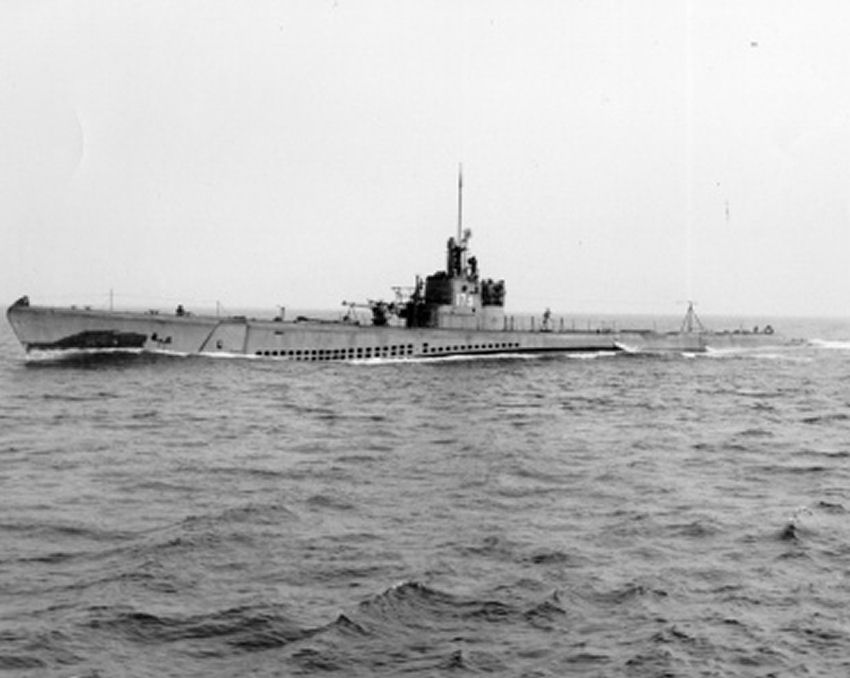

Launched 8July1936
Commissioned 19Nov1936
Decommissioned 15Nov1945
Length 300'7" Test Depth 250' Draft 13'10"
Beam 25'1" Speed 19 kts surfaced, 9 kts submerged
Complement 5 officers and 45 men
War Patrols 12 Battle Stars 13
Ships Sunk 16 (1 DD, 15 Merchants) 102,107 tons
Ships Damaged 7 (1 CL, 1 DD, 5 Merchants) 46,695 tons
Awarded Navy Unit Commendation
The second ship to bear the name "Plunger" was the
SS-179 , launched on 8 July, 1936 at the Portsmouth Navy Yard and commissioned on 19 November of the same year. The Plunger was on her shake down cruise and pulled into Charleston, SC, and this photo was taken of her with the Cooper River Bridge in background probably in the winter of 1936 or early 1937.
Following sea trials and initial outfitting the "Plunger" transited the Panama Canal to report to her homeport in
San Diego, California in November, 1937, her first few years to be spent in routine patrols and exercises.
On December 7, 1941, while in the shadow of Diamond Head, the "Plunger" was making preparations to enter Pearl
Harbor when the Japanese attacked. Entering port the next day, she provisioned and set off in the company of the
Gudgeon and the Pollack as the first three US submarines to go on war patrol in World War Two.
In the following four years the "Plunger" repeatedly went "in harm's way" as she sank
a total of 16 Japanese ships and damaged 7 others, sending a total of 102,107 tons to the bottom. Her impressive
accomplishments during the war included the first wartime penetration of the Sea of Japan, the first (and, until the very
end of the war, the only) submarine to return to the Sea of Japan, rescue of a naval aviator, and the dubious distinction
of being the first US submarine to be depth-charged by the Japanese during the war.
Thes are photos of the actual SS-179 Battle Flag SS-179 Battle Flag view 2 SS-179 Battle Flag view 3
Following her twelfth war patrol, the "Plunger" was sent to Pearl harbor for a much needed overhaul and, in the
winter of 1945, was sent to the east coast where she was finally decommissioned in the Philadelphia Navy yard on 15
November, 1945.
USS Plunger SS-179 Picture Albums by Duane Langshaw
SS-179 Plunger (SS-179) is waterborne at Portsmouth Navy Yard, Kittery, ME. 8 July 1936. She is pictured here docking after launching.
SS-179 Stern view of the Pollack (SS-180) & Plunger (SS-179) at Portsmouth Navy Yard, Kittery, ME. They are pictured here fitting out, circa April 1937.
SS-179 Photo entitled "Weekly Inspection, Permit (SS-178). The Pollack (SS-180) and the Plunger (SS-179) flank the Permit." Naval Recruiting Dept, New York, circa late 1937.
SS-179 Submarines in San Diego harbor, California, 1940. Moored alongside Holland (AS-3), from which the photograph was taken, the submarines are (from left to right): Salmon (SS-182); Seal (SS-183); Pickerel (SS-177); Plunger (SS-179); Snapper (SS-185) and Permit (SS-178).
SS-179 Plunger (P8) (SS-179) backing clear of a nest of submarines, alongside their tender in San Diego harbor, California, in 1940. Other identifiable submarines present are: Salmon (SS-182); Seal (SS-183); and Stingray (SS-186).
SS-179 The Plunger (SS-179) passes under a bridge, probably when she steamed to San Diego to join SubDiv 14, SubRon 6 between November 1937 & November 1941.
SS-179 Plunger (SS-179), circa 1941.
SS-179 SS-179 Japanese Cargo Ship sinking, as photographed through a periscope by Plunger (SS-179). This ship is probably the MS Kinai Maru , sunk by Plunger on 10 May 1943, during her sixth war patrol.
SS-179 Members of the submarine's crew display her battleflag. The man seated in the center appears to be wearing a Japanese sailor's hat. The photograph is dated 21 June 1943, following Plunger's (SS-179) sixth war patrol.
Plunger (SS-179) DANFS history